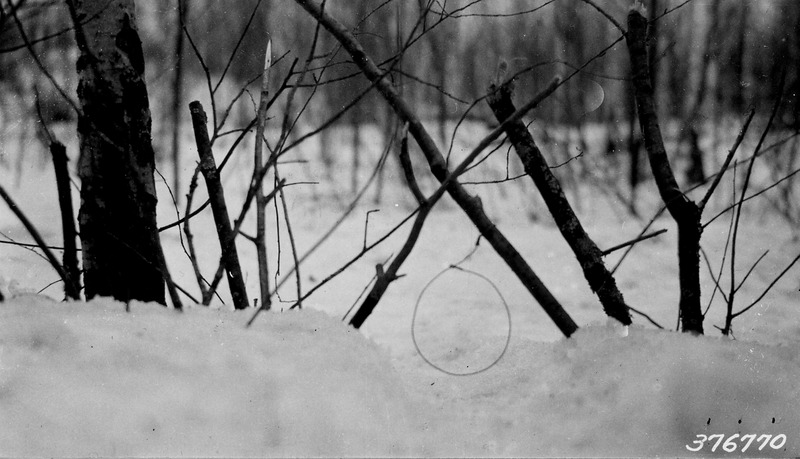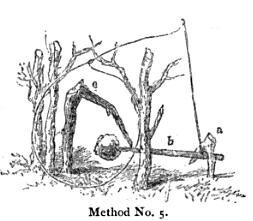This was going to be the final instalment of 'bushcraft and the law' but a few more topics have been suggested so I will address those over the next couple of weeks, today though; SNARES
 |
| A 1935 picture of a snare being used for vermin control; By Unknown or not provided [Public domain], via Wikimedia Commons |
Snares are a very primitive method of trapping and are used
all over the world for a number of tasks, however there are limitations on how
you can use them in this country just as there are limitations and restrictions
placed on all other forms of trapping.
England and Wales operate under the same laws about snaring
but Scotland has its own and I’ll deal with those first as they are simple; You can’t use snares, at least most of
you can’t unless you have attended a specific training course and received an
identification number which must be attached to all snares set. These courses
must be attended by people with good grounds to need to use snares for pest and
predator control and I doubt they would be delivered to people who cite
‘bushcraft’ as their reason. Even with this training snares must be made to a
specified design, which includes a ‘stop’ which prevents a snare closing beyond
a certain point this must be set “at least 23cm” from the eye of the snare.
In England and Wales there is no legal requirement (yet) for
official training nor the requirement for a ‘stop’ on snares although their use
is encouraged by codes of practice produced by BASC, DEFRA and the Game and
Wildlife Conservation Trust. These stops are sometimes called ‘deer stops’ as
they prevent the snare from closing tight enough to snare a deer’s leg. However
the official designation of a snare is as a restraining device which will
humanely hold an animal until it can be dispatched when the snare is checked,
so this stop also acts to stop the snare tightening to the point where it can
choke or cut into a target animal. The other thing which should stop choking or
strangling from occurring is that a snare must be free running, this is a key
phrase in the legislation. To be free running a snare must loosen off when
pressure stops being applied, this will allow an animal to struggle briefly,
pulling the snare tight and then when it realises it is caught stop struggling
and remain without further discomfort, but still firmly caught, until it can be
dispatched or released. A snare which is not free running will tighten up and
remain tight and potentially choke the caught animal, snares can be designed to
operate like this but the law makes no distinction between snares designed not
to be free running, ie; locking, and those which lock due to them being damaged
or corroded. Whether a snare is free
running or not can only be proved by its operation! So it’s up to you to
check that your snares still run freely before setting them, this might be
particularly important if you are making your own snares. Be aware that if you
have caught a few rabbits or foxes in a snare already it will often become so
kinked and twisted that it will not run freely and will have to be discarded,
don’t worry they are cheap.
Regarding twitch up and spring snares, these are not allowed, in Scotland these would be prohibited
by their updated legislation although in
England and Wales it does not specifically say anywhere in legislation that you
can’t use them. However, as we know
snares must be ‘free running’, I would suggest that a spring or twitch up snare
is not free running as when an animal is caught and ‘dangled’ its own body
weight against the wire of the snare will stop it being ‘free running’ thereby
making it illegal.
 |
| A diagram of a type of twitch up snare from the 1882 book Camp life in the woods and the tricks of trapping and trap making. By William Hamilton Gibson [Public domain], via Wikimedia Commons |
As well as following the legal guidelines above you may find
the following useful when setting snares;
Tealers’ are the small sticks which hold the noose of the snare in place over a run. These can be made of wood such as hazel, avoid using green elder as it smells strongly and may put animals off, or from wire. These can be used singly or in pairs where a heavier snare for foxes needs extra support to hold it up. They should be set immediately next to but not on the run that you plan to use the snare on.
The snare must be anchored securely, a long (at least two feet for a fox) wooden stake can be driven into the ground with the snare attached, alternatively a strait or corkscrew style metal stake could be used. It is considered bad practice to anchor a snare to a fence, remember if an animal jumps through or over the fence and dangles from the snare the snare is not free running. The snare must NOT be anchored to something which can move, these used to be called drag snares and were commonly used, they are now illegal.
To set a snare for rabbits; the bottom of the snare should sit four fingers height above the floor of the run, when looking at a well-used rabbit run you can sometimes identify where the rabbits takes it’s forward jumps by looking for the pattern of compressed and uncompressed grass, the snare should be set over the uncompressed portion of grass as at this point the rabbits head will be the first thing to go through the noose.
For foxes the snare should be set a full hands span from the floor, IF YOU THINK THERE MAY BE BADGERS OR OTTERS IN AN AREA DON’T SET FOX SNARES, if set properly you won’t catch a badger in a fox snare but it’s not worth the risk of being accused of trying or having your snare knocked down by a passing pheasant or deer to a level where it might catch a badger.
Tealers’ are the small sticks which hold the noose of the snare in place over a run. These can be made of wood such as hazel, avoid using green elder as it smells strongly and may put animals off, or from wire. These can be used singly or in pairs where a heavier snare for foxes needs extra support to hold it up. They should be set immediately next to but not on the run that you plan to use the snare on.
The snare must be anchored securely, a long (at least two feet for a fox) wooden stake can be driven into the ground with the snare attached, alternatively a strait or corkscrew style metal stake could be used. It is considered bad practice to anchor a snare to a fence, remember if an animal jumps through or over the fence and dangles from the snare the snare is not free running. The snare must NOT be anchored to something which can move, these used to be called drag snares and were commonly used, they are now illegal.
To set a snare for rabbits; the bottom of the snare should sit four fingers height above the floor of the run, when looking at a well-used rabbit run you can sometimes identify where the rabbits takes it’s forward jumps by looking for the pattern of compressed and uncompressed grass, the snare should be set over the uncompressed portion of grass as at this point the rabbits head will be the first thing to go through the noose.
For foxes the snare should be set a full hands span from the floor, IF YOU THINK THERE MAY BE BADGERS OR OTTERS IN AN AREA DON’T SET FOX SNARES, if set properly you won’t catch a badger in a fox snare but it’s not worth the risk of being accused of trying or having your snare knocked down by a passing pheasant or deer to a level where it might catch a badger.
You can also use snares for catching rats, grey squirrels and mink but will have to adapt your method to suit each species and remember the guidelines above. Although it would be a very effective way to catch squirrels to place baited snares along tree branches would the snare be free running if the animal was then to fall off and dangle under it's own body weight?
For further information on the use of snares see the codes
of practice produced by organisations like BASC and DEFRA. Also the full legislation regarding snares can be found spread across several Act's including;
- The Wildlife and Countryside Act 1981
- The Snares (Identification Numbers and Tags) (Scotland) Order 2012
- The Snares (Training) (Scotland) (No. 2) Order 2012
- The Snares (Training) (Scotland) Order 2012
- The Deer Act 1991



No comments:
Post a Comment
Note: only a member of this blog may post a comment.